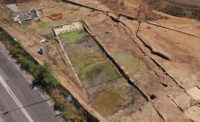 Archaeologists have discovered a monumental pool dating to the 4th century B.C. near the Giardino di Roma neighborhood 10 miles southwest of Rome. The stone sunken pool is a massive 48 meters (157 feet) long and 12 meters (39 feet) wide was discovered during a preventative archaeology excavation at the site of a future residential and commercial real estate complex.
Archaeologists have discovered a monumental pool dating to the 4th century B.C. near the Giardino di Roma neighborhood 10 miles southwest of Rome. The stone sunken pool is a massive 48 meters (157 feet) long and 12 meters (39 feet) wide was discovered during a preventative archaeology excavation at the site of a future residential and commercial real estate complex.
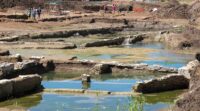 Its function is unclear. The most plausible current hypothesis is that the monumental pool was part of a system of water management, a large reservoir or settling tank. It could also have had an agricultural purpose — an ancient hydroponics farm. Then there’s always the old fallback of unknown ritual purpose. The outer walls were made of tufa blocks and an inclined ramp connects the pool to the street level of the time. This was not a Roman-style public bathing facility or anything else familiar on the archaeological
Its function is unclear. The most plausible current hypothesis is that the monumental pool was part of a system of water management, a large reservoir or settling tank. It could also have had an agricultural purpose — an ancient hydroponics farm. Then there’s always the old fallback of unknown ritual purpose. The outer walls were made of tufa blocks and an inclined ramp connects the pool to the street level of the time. This was not a Roman-style public bathing facility or anything else familiar on the archaeological 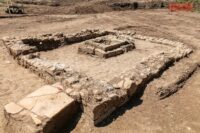 record. The two-hectare site is replete with layers of building and structures and artifacts that have been discovered range over eight centuries starting in the 5th century B.C.
record. The two-hectare site is replete with layers of building and structures and artifacts that have been discovered range over eight centuries starting in the 5th century B.C.
At the time the pool was built, the area was already an important crossroads connecting the city of Rome and its first colony, Ostia, which according to legend was founded by Ancus Marcius, fourth king of Rome, in the 7th century B.C.
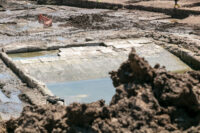 The artifacts recovered may provide additional clues to the usage of the pool and other structures over different historical phases. One of the remains found may be of particular import: it’s a wooden fragment, preserved in the watery bottom of the pool, inscribed in Etruscan. At the time, the Etruscan language was used by Latin communities as well, including Rome.
The artifacts recovered may provide additional clues to the usage of the pool and other structures over different historical phases. One of the remains found may be of particular import: it’s a wooden fragment, preserved in the watery bottom of the pool, inscribed in Etruscan. At the time, the Etruscan language was used by Latin communities as well, including Rome.
“The excavation, in all its grandeur, reveals an important place” – explains superintendency archaeologist Barbara Rossi – “which lasted for over eight centuries, as demonstrated by the quantity and above all the quality of rediscovered structures, such as the monumental basin from the fourth century BC, found in all its expanse.”
“An in-depth study of the large number of materials that this investigation has returned to us and continues to return to us – wood, terracotta, metal objects, inscriptions – will reveal the secrets of this extraordinary corner of the greater Rome area.”
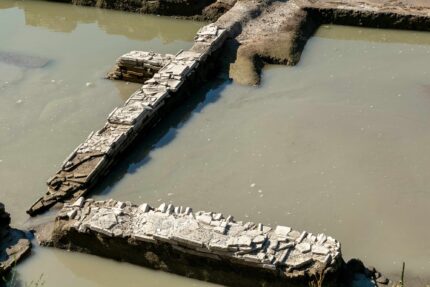
Quamvis sint sub aqua, sub aqua maledicere temptant 👿
——–
“At the time the pool was built, the area was already an important crossroads connecting the city of Rome and its first colony, Ostia.”
——–
Their first colony also happened to be their first overseas harbour.
In addition to the river, there were artificial channels connecting the city and its harbour, and of course those needed water management too.
–Just my 2 sesterces.
:hattip:
Fish farm for the garum industry?
Looks to me like a boat ramp, or launching slip.
Why is there a ramped entrance to the big pool? You don’t need a ramp in a reservoir/cistern unless it’s for cattle or people to get in and out? And what was the purpose of the site being re-filled with water in the photos?
I love this website – thank you so much for providing it.
Perhaps it was the original wave pool…
I wondered about the ramp as well. I assume that the area is waterlogged, judging by the reeds and other wetland plants, but was it so in Roman times? It all kind of resembles a building site flooded after heavy rain, rather than pools with the required walkways between them.